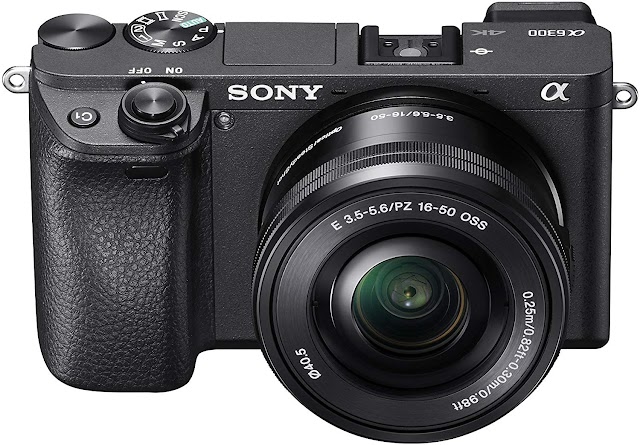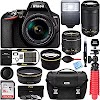Pentax K-1 II is the next generation of Pentax K-1 DSLR cameras from 2016. Like its predecessor, it has a 36.2MP full-frame CMOS sensor without anti-aliasing filter, 5-axis image stabilization with a sturdy design.
Introduced more as a refinement of its predecessor, this camera is predicted to be a full-frame camera that is very weather resistant. K-1 II gets a new handheld Pixel Shift mode and an increase in the AF tracking algorithm, it also has a new pre-processor. The price of the Pentax K-1 Mark II is priced at 25 million.
The Pentax K-1 II maintains the magnesium-alloy body which is weather resistant and still the same as the Pentax K-1. This body is weather resistant overall, with a total of 87 seals that protect the same layer, compartment and control from the entry of dust or moisture.
And if you buy an optional portrait / battery grip, it has 47 seals. Besides being dust and water resistant, the K-1 II is also frozen resistant, capable of operating at temperatures as low as 14 ° F (-10 ° C). Pentax provides K-1 II with a 36.4 megapixel full-frame CMOS image sensor with Bayer RGBG color filter array.
The dimensions are 35.9 x 24mm, a total resolution of 36.77 megapixels, and a pixel pitch of 4.9 microns. The maximum image size is 7,360 x 4,912 pixels, except when operating in APS-C trimming mode, when the resolution reaches 4,800 x 3,200 pixels (or in other words, 15.3 megapixels).
Like other Pentax DSLRs since the K-3, K-1 II did not include an optical low-pass filter. However, the on-demand mechanical antialiasing function features. More about that soon. Inside the K-1 II there is also a Ricoh PRIME IV processor.
Where PRIME IV processors in K-1 II are now aided by what is called Ricoh as an "Accelerator Unit". This chip allows for noise reduction processing, because the Pentax KP and K-1 II both offer extremely wide sensitivity ranges.
The overall sensitivity range has also been increased from ISO 100 to ISO 819,200. There is also an ISO automatic sensitivity function, the upper limit of which can be manually selected. And like the previous camera, you can configure the Pentax K-1 II to increase sensitivity more or less quickly than the standard.
With a manufacturer rating of 4.4 frames per second, it also follows competitors such as Nikon D810, Canon EOS 5DS R and Sony Alpha A7R II, all of which rank at five fps. This is also a form of Pentax's readiness to face its competitors.
If you apply the APS-C sensor, the K-1 II is capable of shooting around 6.4 frames per second. Strangely, it's only slightly slower than the number for K-1, which is 6.5 fps. Full resolution mode can capture around 70 JPEG or 17 raw frames in one burst, while APS-C mode will allow up to 100 JPEG or 50 raw frames in one burst.
Low speed burst modes have a greater burst depth. For full frame shooting, Ricoh claims burst depths of up to 100 JPEG or 20 raw images at three fps, or 100 raw images / JPEG at 0.7 fps.
Trim it to APS-C then the depth of 100 becomes JPEG or 70 raw images at three fps, or 100 raw images / JPEG at one frame per second. Like the previous K-1, K-1 II included stabilization of in-body images.
This is a more sophisticated system than the one on the APS-C flagship K-3 series camera. Where the models are limited to three-axis Shake Reduction and have a maximum correction of around 4.5. The K-1 II offers five-axis stabilization and a five-stop corrective range, just like its predecessor.
The K-1 II also includes a panning detection function. This determines that you are panning to follow the moving subject, and then automatically stops the effort to stabilize the movement on the axis but still stabilizes the other axis.
Now the K-1 II also has Pixel Shift Resolution mode, where this mode was initially applied to the Olympus OM-D E-M5 Mark II camera. This mode combines several sequential images with a slight adjustment of the position of the image sensor to create a single image output with higher quality.
Ricoh has maintained the DR II dust removal system that is the same as that used in other flagship models since K-7 for the new K-1 II. This uses a piezoelectric element that vibrates at a higher frequency than the sensor system can.
For the Autofocus system, K-1 II still uses the autofocus sensor 33 points the same on K-1. This system is nicknamed SAFOX 12, it has the same settings as the previous SAFOX 11 design. But it places three additional AF points on both sides of the main array, right inside two linear AF points at the far left and rightmost ends of the array.
25 central points in a 5 × 5 array are all cross types, sensitive to details on horizontal and vertical axes. The remaining eight dots, located on the left and right ends of the array, are sensitive linear points on only one axis. The middle sensor and the points just above and below it are precision points, able to focus with an aperture of f / 2.8. These same points also have a working range of -3 to + 18EV.
The choice of auto focus mode includes AF-S (single-servo), AF-C (continuous-servo), and automatic selection (AF-A). You can also switch from 33 default automatic selection, with conditions for Spot, Select, Small / Medium / Large Expanded or zone-select modes.
K-1 II is equipped with a built-in GPS receiver, electronic compass and three-axis orientation sensor. K-1 can also record song logs in KML format used by Google Earth, recording your location at intervals of 5, 10, 15, 30 or 60 seconds, with a duration of up to 9 hours at minimum intervals or 18 hours at 10-second intervals.
Ricoh started a new pentaprism viewfinder at the Pentax K-1, and it was maintained in the follow-up camera too, still using 100% coverage which was assessed by an accurate manufacturer. In place of the LED focal point indication used in the sub-frame model, it displays a lit LCD overlay that provides an adjustable lattice display, indication of crop area if applicable, and a dual axis level gauge display.
Full Specifications of Pentax K-1 Mark II
| General | |
|---|---|
| Brand | Pentax |
| Model | Pentax K-1 Mark II |
| Announced | 2018-02-22 |
| Body Type | Mid-size SLR |
| Lens | |
| Manual Focus | |
| Lens Mount | Pentax KAF4 |
| Number of Lenses | 148 |
| Focal Length Multiplier | 1� |
| Macro Focus Range | n/a |
| Screen | |
| Screen Type | Fully Articulated |
| Screen Size | 3.2" |
| Screen Resolution | 1,037k dots |
| Live View | |
| Touch Screen | |
| Viewfinder | |
| Viewfinder | Optical (pentaprism) |
| Viewfinder Resolution | no electronic viewfinder |
| Viewfinder Coverage | 100% |
| Viewfinder Magnification | 0.7 |
| Photography Features | |
| Min Shutter Speed | 30s |
| Max Shutter Speed | 1/8000s |
| Continuous Shooting | 4.4 fps |
| Shutter Priority | |
| Aperture Priority | |
| Manual Exposure Mode | |
| Exposure Compensation | Yes |
| Custom White Balance | |
| Image Stabilization | |
| Built-in Flash | |
| Flash Range | no built-in flash |
| Max Flash Sync | 1/200s |
| Flash Modes | Auto Flash Discharge, Auto Flash + Red-eye Reduction, Flash On, Flash On + Red-eye Reduction, Slow-speed Sync, Slow-speed Sync + Red-eye, P-TTL, Trailing Curtain Sync, Contrast-control-sync, High-speed sync, Wireless sync |
| External Flash | |
| AE Bracketing | |
| WB Bracketing | |
| Exposure Modes | |
| Multi-Segment | |
| Average | |
| Spot | |
| Partial | |
| AF-Area | |
| Center Weighted | |
| DxO Sensor Scores | |
| DxO Overall Score | not tested |
| DxO Color Depth | not tested |
| DxO Dynamic Range | not tested |
| DxO Low Light ISO | not tested |
| Sensor | |
|---|---|
| Sensor Type | CMOS |
| Sensor Size | Full frame |
| Sensor Dimensions | 35.9 x 24 mm |
| Sensor Area | 861.60mm2 |
| Sensor Resolution | 36 megapixels |
| Max Image Resolution | 7360 x 4912 |
| Max Native ISO | 819,200 |
| Min Native ISO | 100 |
| RAW Support | |
| Autofocus | |
| AF Touch | |
| AF Continuous | |
| AF Single | |
| AF Tracking | |
| AF Selective | |
| AF Center | |
| AF Multi Area | |
| AF Live View | |
| AF Face Detection | |
| AF Contrast Detection | |
| AF Phase Detection | |
| Number of Focus Points | 33 |
| Number of Cross Focus Points | 25 |
| Video Features | |
| Video Resolutions | 1920 x 1080 (60i, 50i, 30p, 25p, 24p), 1280 x 720 (60p, 50p) |
| Max Video Resolution | 1920 x 1080 |
| Video Formats | MPEG-4, H.264 |
| Microphone Port | |
| Headphone Port | |
| Connectivity | |
| Wireless Connectivity | Auto Flash Discharge, Auto Flash + Red-eye Reduction, Flash On, Flash On + Red-eye Reduction, Slow-speed Sync, Slow-speed Sync + Red-eye, P-TTL, Trailing Curtain Sync, Contrast-control-sync, High-speed sync, Wireless sync |
| HDMI | |
| USB | USB 2.0 (480 Mbit/sec) |
| Physical | |
| Environmental Sealing | |
| Water Proof | |
| Dust Proof | |
| Shock Proof | |
| Crush Proof | |
| Freeze Proof | |
| Weight | 1010g |
| Physical Dimensions | 137 x 110 x 86mm |
| Battery Life | 670 shots |
| Battery Type | Battery Pack |
| Battery Model | D-LI90 |
| Other Features | |
| Self Timer | Yes (2 or 12 sec, custom) |
| Timelapse Recording | |
| GPS | Built-in |
| Storage Type | Dual SD/SDHC/SDXC (UHS-I) |
| Storage Slots | 2 |







0 Comments